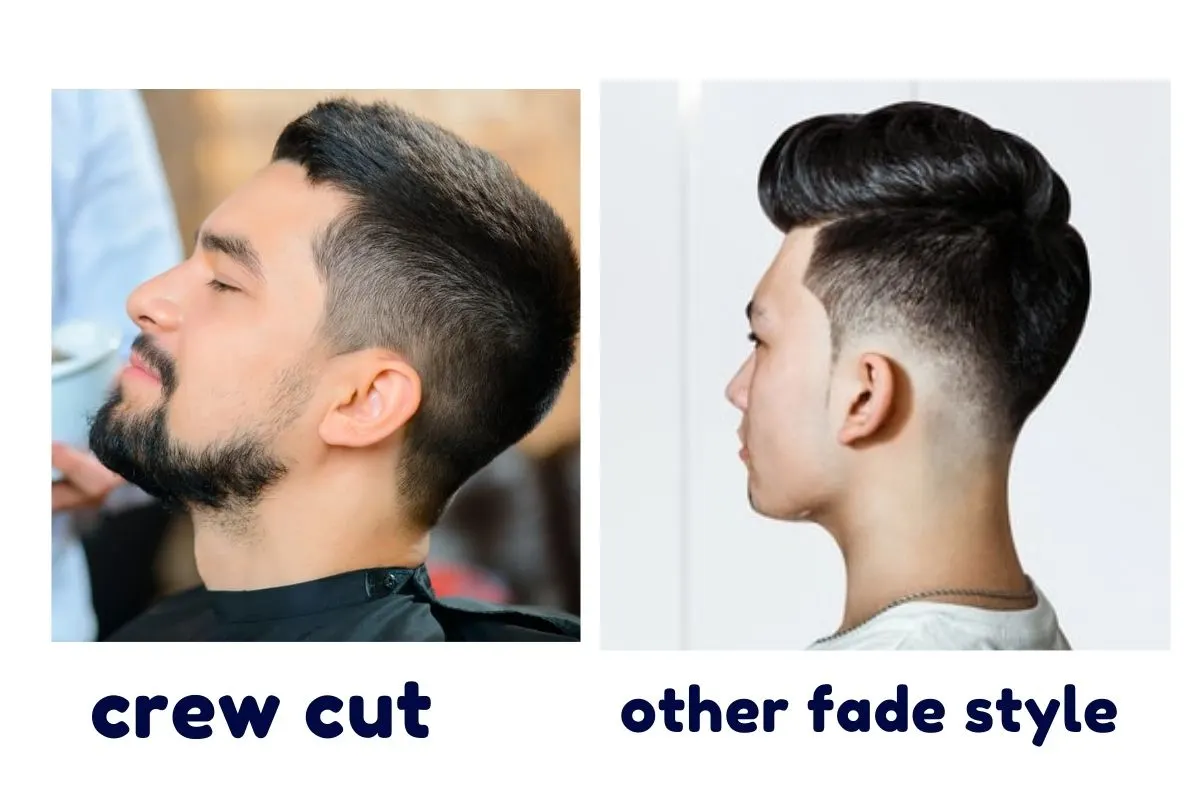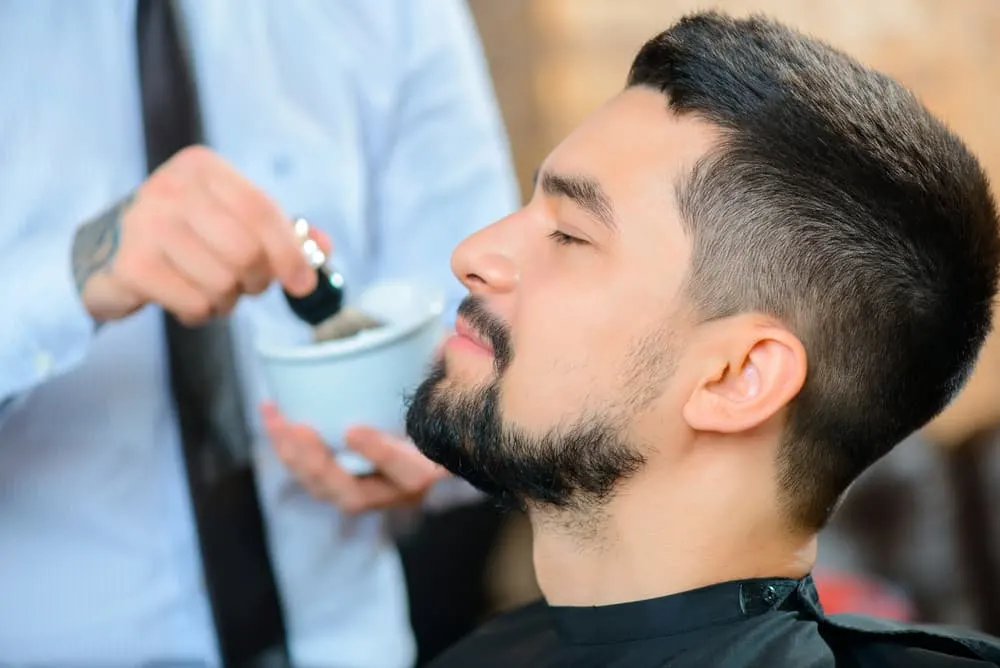There are some hairstyles that you never want to confuse. You don’t want to end up asking for a style you never actually wanted due to a misunderstanding. So, what’s the difference between a crew cut and a fade?
A “crew cut” is a specific hairstyle where the top is longer than the short, clipped sides and also tapers from front to back. A “fade” is a feature of many different hairstyles where there is a gradual increase and blending of lengths at the sides and back.
Although that’s the gist – let’s dig deeper.
Photos, descriptions, and more.
Crew Cut Vs Fade: Key Differences
The two are so different that once you’ve read this, you’ll never confuse them.

Images From Deposit Photos And Shutterstock
1. Feature Vs Style
A “crew cut” is a style, while “fade” is a feature of a style.
Let me explain.
As I mentioned, crew cuts are a hairstyle where the hair on top is scissor-cut and left longer than the clipped down sides. The top also graduates in length (i.e gets shorter) as you go from the front to the back.
“Fade”, on the other hand, refers to the gradual increase in length from the bottom of the sides and back to the top. The different lengths seamlessly blend into one another with no harsh lines. This is what creates that classic “faded” or blurred appearance.
A crew cut is a hairstyle in itself, while a fade can be included in many different hairstyles.
2. Specificity
The “crew cut” has a pretty strict and specific definition.
When you ask a barber for a crew cut, you would know what to expect – or at least you should.
You should expect hair on top that’s longer than the buzzed down sides. In addition, the hair on top should be longer at the front than it is at the back, almost creating a small pomp at the frontal hairline.
The hair on top is generally long enough to style a little but not long enough to form a side part with.
When you ask for a “fade”, however, you really aren’t telling the barber very much.
You need to tell them what you want on top to go with the faded sides and back. You could literally have anything on top – ranging from buzz cuts, to pompadours, to quiffs, to man buns.
Any style can be combined with a fade.
In addition, you’ll need to tell the barber how short you want the fade and how high up you want the fade.
Skin fades, low fades, mid fades, high fades – you need to get more specific with it to ensure you get the look you want.
The point here is that the term “crew cut” is specific and you don’t really need to say much more.
Meanwhile, the term “fade” means nothing on its own.
Now that I’ve explained the difference between the two terms, I’ll round things off by saying that crew cuts often include faded sides as part of the overall style.
Remember, a fade can be included in practically any hairstyle – this includes crew cuts. In fact, fades very commonly are included in crew cuts.
Crew Cut Examples
Here are some examples of this classic men’s hairstyle you can use as a source of inspiration.
Crew Cut With 1 Fade
Here’s a great example of how a crew cut includes faded sides.

As you can see, the hair on top is short but not that short. It appears to taper in length from the front to the back so that it almost appears horizontal from the side.
This is typical for crew cuts.
As is the case with most crew cuts, the sides include a fade. This appears to be a 1 fade, as the shortest length of the fade looks approximately a #1 length (3mm).
Facial hair is a great way to add balance to the crew cut and definition to the lower portion of the face.
Crew Cut With Small Quiff
Here’s an example of a crew cut with the forelock (hair immediately above the forehead) gently brushed upward to form a small quiff.

Remember, one of the great things about crew cuts compared with regular induction-style buzz cuts is that the hair is often just about long enough to style.
You won’t be able to do much with it by any means.
But you’ve often got something there to work with, even if it means it’s just a small quiff like this.
It’s great for men with round faces because it means you can add some height up top to elongate the face.
But the beauty of it is that you still retain a lot of the benefits that shorter buzz cut variations have, such as ease of maintenance (washing and drying etc).
Long Crew Cut With Fade
Here’s a longer crew cut with the classic tapering of length up top. It’s subtle, sleek, and effortlessly neat.

The sides here are exceptionally well faded with the seamless blending on various lengths, gradually increasing as you go from a #0 length at the bottom up to the longer hair further up.
The longer hair here gives you more flexibility in terms of styling – there’s just more you can do with it.
It’s long enough to build some texture with a hair paste or hair clay if you wanted to.
This does make it a little higher maintenance than shorter crew cut styles, however. It’s a tradeoff, but one that many people would say was worthwhile.
Fade Examples
You’ve now seen a few examples of crew cuts. In fact, you’ve seen crew cuts that actually include fades.
Now you’ll see a few other styles that include fades as well. It goes to show just how varied it can get when it comes to fades, while crew cuts have a pretty strict definition.
Remember, fades can be combined with practically any hairstyle up top.
Buzz Cut With Mid Skin Fade
This is an induction-style buzz cut – the hair on top is clipped down very evenly and very shortly.

Although the sides are faded and technically shorter than the top (like a crew cut), the top is clipped down as opposed to scissor cut. It’s also much shorter than what you’d expect from a crew cut.
This one is what you’d call a “mid” skin fade, bordering on a “high” skin fade, simply because of how high up the sides the shortest part of the fade reaches.
In addition, it’s a “skin fade” because the shortest length of the fade is literally shaved.
Pompadour With Fade
A pompadour is a large, voluminous hairstyle where the hair on top is swept backward and upward. It’s a vintage hairstyle that is often combined with a fade to give it a modern edge. Here’s an example.

The fade here appears to be a 1 fade as the shortest length of the fade is approximately a #1 length (3mm).
As you can see, it’s more subtle than the skin fade in the picture before.
It’s a “low fade” because the shortest length of the fade (#1 length) doesn’t go further than around half an inch above the ear.
Overall, it’s a subtle fade – a nice way to compliment the more in-your-face pompadour up top.
Faux Hawk With Fade
The faux hawk is yet another hairstyle commonly combined with a fade. It’s where there’s a spiked or textured strip of hair up top that gradually blends into the sides. The sides are often faded, as you can see from the skin fade in the photograph below.

Much like its more outlandish cousin the “mohawk”, the faux hawk does turn heads. However, it’s more subtle and generally considered more versatile.
The faded sides help to gradually blend the sides into the textured strip of hair up top, as opposed to transitioning sharply as they would with a mohawk.
While crew cuts aren’t quite as bold, the subtle way in which the sides gradually blend into the hair on top with both of these styles is very pleasing to the eye.
Crew Cut Vs Other Fade Style: How To Choose
Choose a crew cut if you want a style that’s effortlessly neat, easy to maintain, subtle, and has a classic aesthetic to it. If you’d prefer a bolder or more striking style that stands out from the crowd, a different fade style may be more appropriate.
Once again, the crew cut is a style that often includes a fade. The fade is a feature that can be included in practically any hairstyle.
So, how do you choose between a straightforward and well-defined crew cut vs a different faded style?
Considering the fact that “other faded style” includes an endless number of styles, the real question is whether the crew cut is for you.
The benefits of crew cuts include the following:
- They’re easy to maintain and effortlessly neat and tidy.
- You can actually style them (a bit). You can’t do much with them, but they’re more versatile than induction buzz cuts in this respect.
- They are great for men with rounder or shorter face shapes who find that induction-style buzz cuts make their faces look even rounder. Having just a little bit of hair up top (like with a crew cut) allows you to add some length to the face.
The downsides of crew cuts include the following:
- It’s hard to stand out with a crew cut. It’s a classic and very common style and some people may want something a little bolder or in-your-face.
- They aren’t as simple to DIY as an induction-style buzz cut would be. If you want a style you can do yourself, crew cut won’t be the one.
If the downsides outweigh the benefits, a different faded style may be a better option for you than the crew cut.
Hopefully, the pictures above might give you some inspiration and ideas for this.
Conclusion
There you have it.
Hopefully, that has cleared up any confusion you may have had about the terms “crew cut” and “fade”.
Knowing the terminology may not seem that important. But confusion about it leads to so many misunderstandings between barbers and clients.
When it comes to these two terms, that should be much less likely for you now.
Enjoy.
Ready Sleek founder. Obsessed with casual style and the minimalist approach to building a highly functional wardrobe. Also a fan of classic, vintage hairstyles.

![Crew Cut Vs Fade: What’s The Difference? [Photos]](https://www.readysleek.com/wp-content/uploads/2021/10/crew-cut-vs-fade-720x405.jpg)





